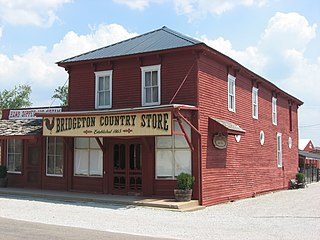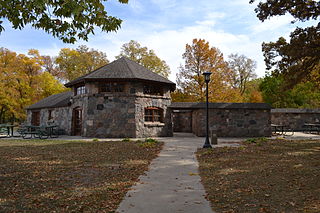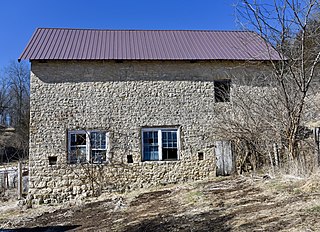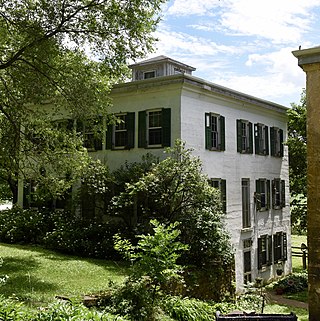Rockdale, Iowa was a small unincorporated village formerly located just south of Dubuque, Iowa between Dubuque and Key West, Iowa. The village was situated on the Catfish Creek in Dubuque County, Iowa, and was the site of one of the first mills in the state of Iowa.

Bridgeton is an unincorporated community in Raccoon Township, Parke County, in the U.S. state of Indiana. It is notable for its covered bridge, which was destroyed on April 28, 2005, by a fire set by an arsonist. A historically accurate reconstruction of the bridge was completed in October, 2006.

The Andrew Zirkle Mill is a 1760s era grist mill located in the southern end of Shenandoah County, Virginia. The mill was added to the National Register of Historic Places in 1983 after being restored by Glenn Hofecker, the owner at the time. The mill is cited as a prime example of the architecture and construction of grist mills and manufacturing facilities of its era.

Florence Mill, also known as the Weber Mill, is a historic mill located at 9102 North 30th Street near the 30th Street exit on I-680 in the Florence community in North Omaha, Nebraska. It was built in 1846 and operated into the 1960s. It was listed on the National Register of Historic Places as Weber Mill in 1998. The mill is also known as the Mormon Mill, Grist Mill, and Old Pink Mill. It is now operated as the Winter Quarters Mill Museum and ArtLoft Gallery.

The Malvern Roller Mill, also known as Appel Mill and Malvern Milling Company, is a 19th-century grist mill located near the unincorporated village of Malvern, Illinois, in rural Whiteside County, north of Morrison, Illinois, United States. The original mill on the site, built by 1853, was destroyed by a flood and the present mill was erected in 1858. The mill's first owner was William P. Hiddleson who operated the mill until he sold to Benjamin Hough in 1871. The mill changed hands over the years until it landed under the control of George Appel in 1892. The Appel family closed the mill in 1942 but it remained in their family until 1985. The Malvern Roller Mill was added to the U.S. National Register of Historic Places in 1995.

The Mansfield Roller Mill or Mansfield Mill is a (gristmill) that was built in Mansfield, Indiana, United States by Jacob Rohm in 1875. This building replaced an older mill that dates back to 1821 built by James Kelsey and Francis Dickson;

The Gray–Watkins Mill or Gray's Mill is a historic structure in Montgomery, in the U.S. state of Illinois. The building was an early turbine mill on the Fox River, and was later used by an automobile parts manufacturer. It was listed on the National Register of Historic Places in 1979.

The Nathan Cooper Gristmill is a historic gristmill on the Black River located at 66 NJ Route 24 in Chester Township, Morris County, New Jersey. It was added to the National Register of Historic Places on November 21, 1976 for its significance in industry.

Benson Grist Mill is a restoration-replica museum located in Tooele County, Utah in the western United States, which allows visitors to see the inner workings of a latter-nineteenth-century pioneer gristmill. It has four other historic (nineteenth-century) buildings which have been moved onto the site, as well as four ancillary structures, including an open-air pavilion. It covers 6.98 acres along State Highway 138, 0.8 mile southwest of the intersection of the Road with State Highway 36. The museum is owned and operated by a division of Tooele County.

Beeds Lake State Park is located northwest of Hampton, Iowa, United States. It was listed has a historic district on the National Register of Historic Places as Beeds Lake State Park, Civilian Conservation Corps Area in 1990. At the time of its nomination it contained 21 resources, which included one contributing building, 15 contributing structures, and five non-contributing structures. The 319-acre (129 ha) park surrounds a 99-acre (40 ha) reservoir. It features hiking trails, boating, fishing, swimming, camping, picnic areas and shelters, lodges and concessions.

Meek's Flour Mill is a historic building located in Bonaparte, Iowa, United States. William Meek and Dr. R.N. Cresap laid out the town of Meek's Mill in 1837. Although the town was renamed Bonaparte in 1841, the Meek family had a central role in its development through the turn of the 20th-century. The present building is a three-story, gable roofed, rectangular structure that was built on a raised basement of ashlar limestone blocks. It was constructed in 1878 by William's son Robert, who had succeeded his father in running the family businesses. He was assisted by his brothers Isaiah and Joseph. It replaced the original 1844 mill, which had been destroyed in a fire. While built on the same site, it is unknown if any part of the present structure was a part of the original mill. Two other structures belonging to the Meek's family are located nearby: a woolen mill (1853), and a saw mill (1860).
The George Dyas House is a historic house located south of Bellevue, Iowa. It is one of over 217 limestone structures in Jackson County from the mid-19th century, of which 101 are houses.

The William Dyas Barn is a historic agricultural building located south of Bellevue, Iowa, United States. It is one of over 217 limestone structures in Jackson County from the mid-19th century, of which 58 are non-residential, agricultural related structures. The stones used to build the barn were quarried, but they vary widely in size and shape. The larger stones are at the bottom of the structure, and they diminish in size the higher up on the walls. An unusual feature on this barn is that the gable ends are not stone, but timber. The Dyas family were among the first settlers in Jackson County, arriving in 1833. They built five houses in this valley. William Dyas built a brick house along with this barn. It is believed there were many more stone barns in the county, but they have been removed over the years. That gives this barn the added significance of being an example of a vanishing building type. It was listed on the National Register of Historic Places in 1991.

Paradise Farm are historic agricultural and domestic buildings located west of Bellevue, Iowa, United States. Massachusetts native Elbridge Gerry Potter settled near Big Mill Creek in 1842 from Illinois. He arrived here with 500 head of cattle, 40 teams of mules, and money. In addition to this farm he operated a flour mill and sawmill in Bellevue, and established steamboat lines on the Mississippi River at Bellevue, on the Yazoo River in Louisiana and the Red River in Texas.

The Motor Mill Historic District is a nationally recognized historic district located southeast of Elkader, Iowa, United States. It was listed on the National Register of Historic Places in 2014. In 1977 it had been listed as a contributing property in the Motor Townsite.

The Grist Mill Bridge, Dam and Mill Site consists of three structures located along Upton Road between Island Road and the Maple River, one-half mile west of Elsie, Michigan in Duplain Township. The three structures are:

The Bellevue Gothic Mill is a historic gristmill located on the west bank of Battle Creek, at 218 East Mill Street in Bellevue, Michigan. It was a producing grist mill from 1854 until 1958. It was listed on the National Register of Historic Places in 1975. In 1977 The Stockhausen family purchased the property and began to restore the building. In 1982 The Bellevue Mill housed Michiana Hydroelectric and produce 45kW. A Michigan Historic marker was erected in 2016.

The Cortright- H. Van Patten Co. Mill was a grist mill located at 109 Byron Street in Homer, Michigan. It was listed on the National Register of Historic Places in 1979. It was destroyed by fire on May 17, 2010.

The Wooster Sawmill and Gristmill Site is a historic industrial site on Park Road in Oxford, Connecticut. From at least 1747 until 1965 it was operated as a sawmill, gristmill, and cider mill, giving it one of the longest known histories as a water-powered mill complex in the United States. The surviving elements of the complex, its structures now converted to private residential use, were listed on the National Register of Historic Places in 2001.

The Columbia Historic District is a neighborhood in Cedarburg, Wisconsin, that is listed on the National Register of Historic Places. At the time the district was listed on the register, its contributing properties included 128 historic homes, one church, and eighty-seven historic outbuildings, including garages and barns, all constructed between 1844 and 1938. The district also contained several dozen buildings that do not contribute to the historic district, including modern homes from the post-war era as well as modern garages and other additions to historic properties.





















